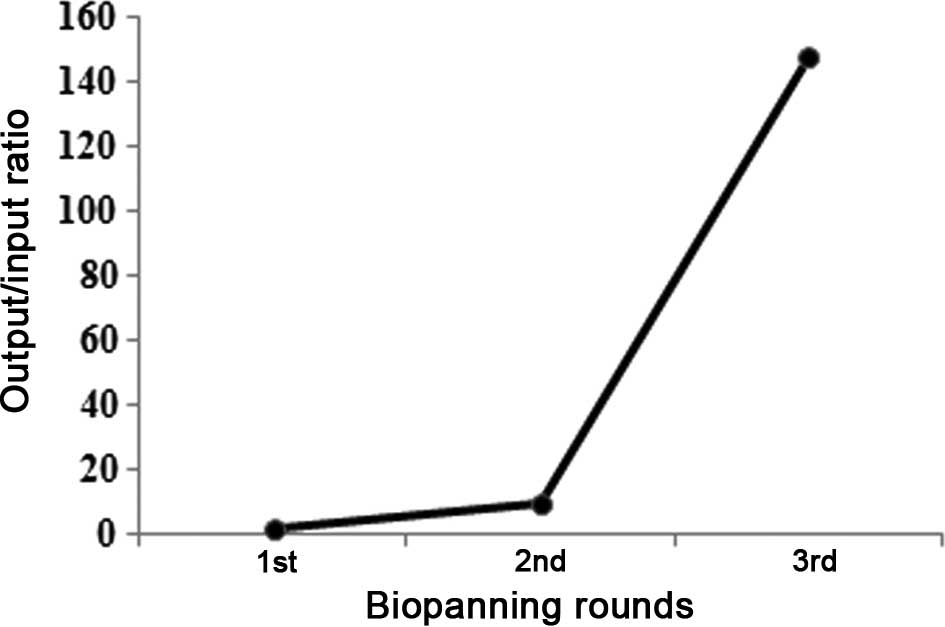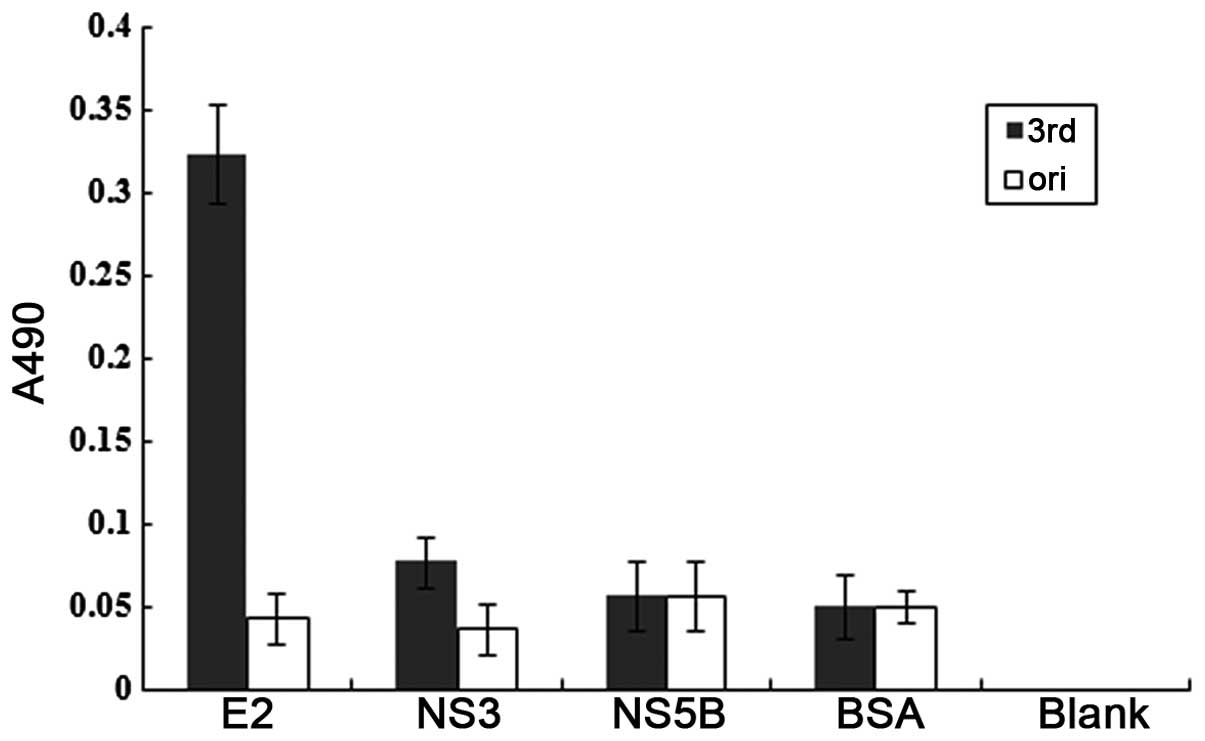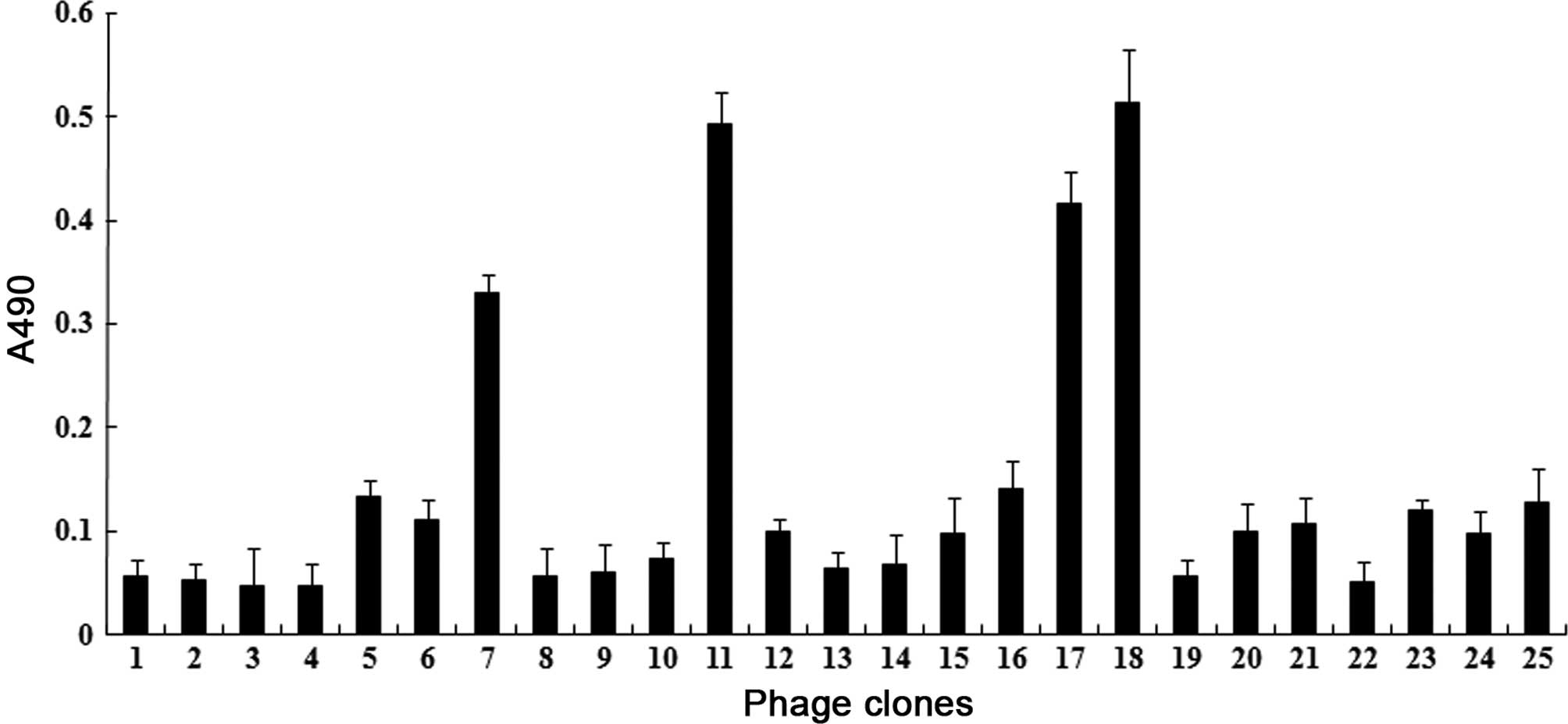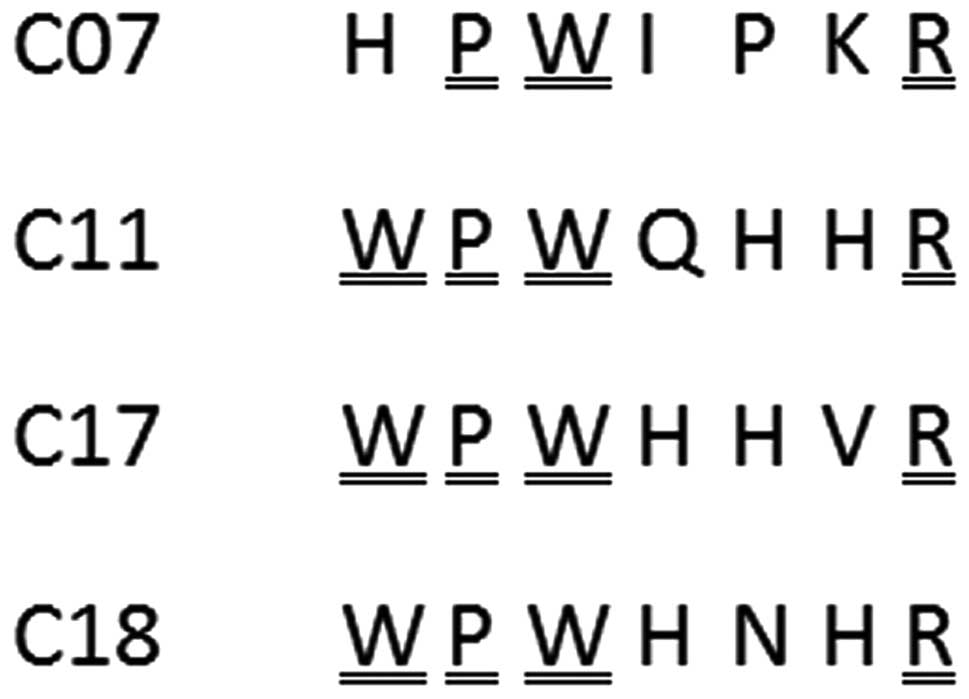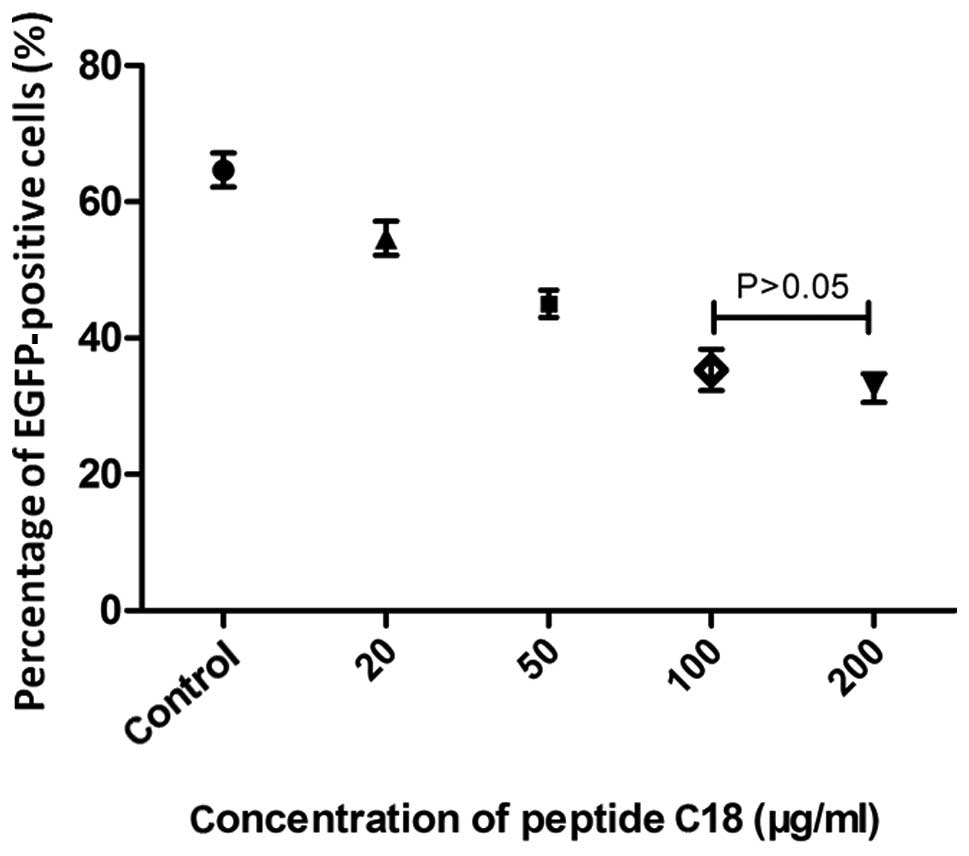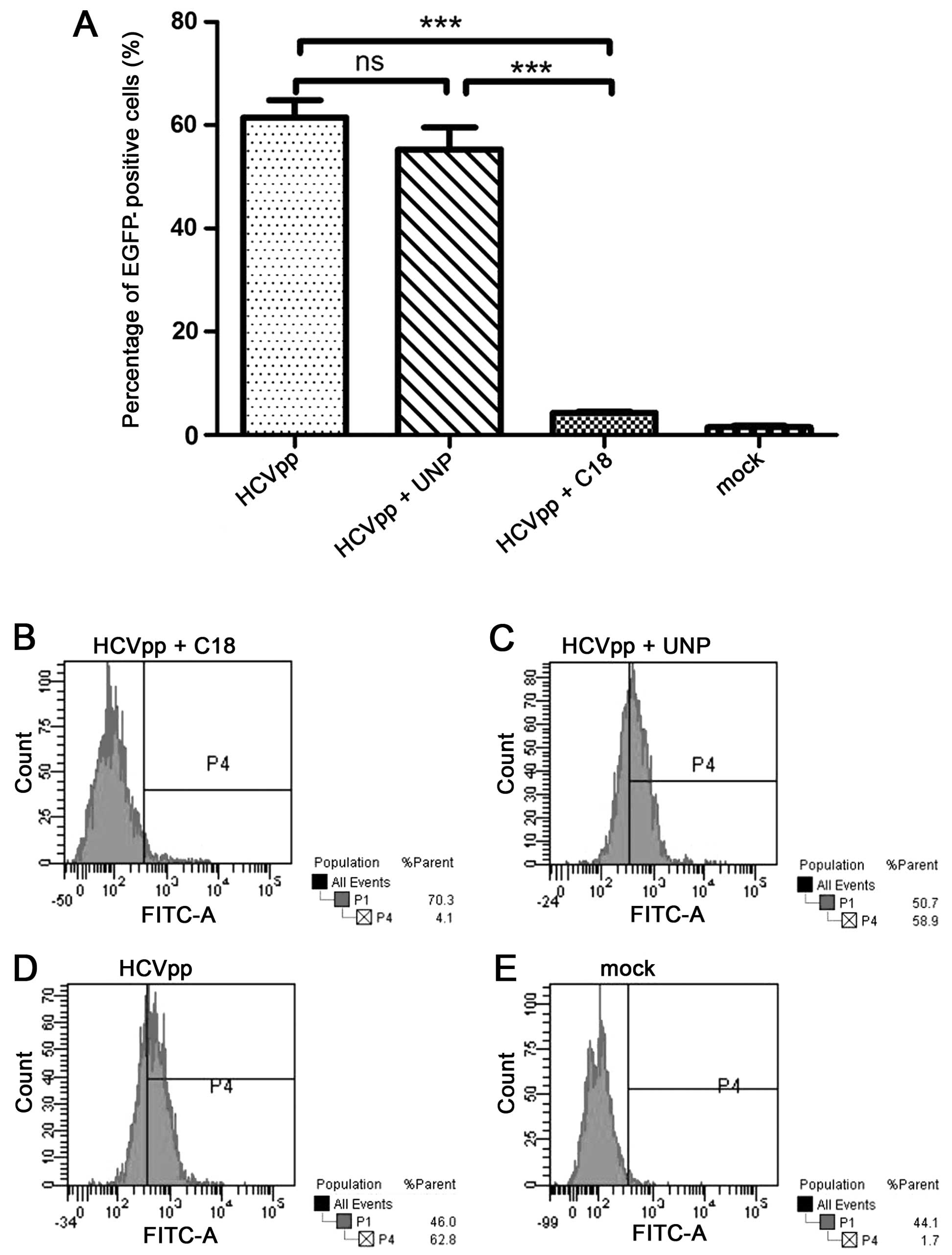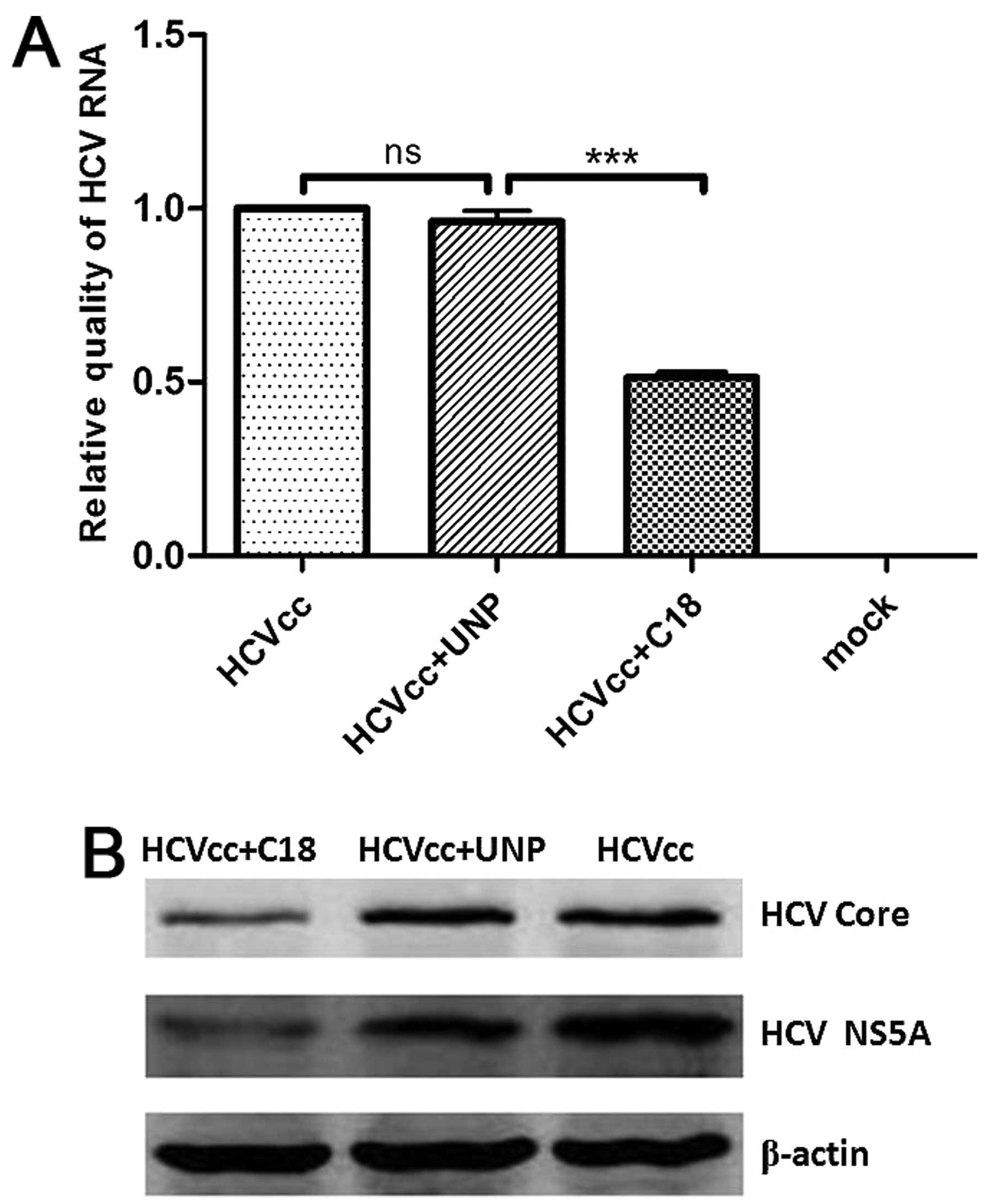Identification of peptides that bind hepatitis C virus envelope protein E2 and inhibit viral cellular entry from a phage-display peptide library
- Authors:
- Published online on: February 25, 2014 https://doi.org/10.3892/ijmm.2014.1670
- Pages: 1312-1318
Abstract
Introduction
Over 170 million individuals worldwide are infected with hepatitis C virus (HCV), which is a major causative agent of liver disease. HCV infection persists after primary infection in the majority of infected individuals, often leading to fibrosis, cirrhosis or hepatocellular carcinoma (HCC). However, no effective prophylactic vaccines or drugs against HCV are currently available (1,2).
HCV is an enveloped virus that belongs to the genus Hepacivirus in the Flaviviridae family, with a positive single-stranded 9.5 kilobase (kb) RNA genome. HCV genomic RNA encodes a polyprotein precursor of ~3,000 amino acid (aa) residues, which is cleaved by a combination of host and viral proteases into at least 10 proteins: the core, envelope proteins (E1 and E2), p7, and non-structural 2 (NS2), NS3, NS4A, NS4B, NS5A and NS5B proteins (3). Envelope proteins are type 1 transmembrane proteins with N-terminal ectodomains and C-terminal hydrophobic anchors (4). The proteins E1 and E2, especially E2, mediate viral entry into target cells, which is an obligatory step in virus replication and the maintenance of infection (5,6). The frequency of HCV genomic mutation is relatively high, and the virus is divided into six major genotypes and multiple subtypes (7). In general, despite strong amino acid variability, almost all viruses enter cells via specific cell receptors, which are distinct for different genotypes of viruses (8–11). Drugs targeting the viral entry step may provide a potential candidate for anti-HCV therapy, with the HCV E2 protein serving as an ideal target.
Full-length E2 protein extends from amino acids 384 to 746 of the HCV polyprotein and contains regions of extreme variability. The C-terminal truncation of E2 at residue 661 (E2661) or 715 (E2715) leads to the secretion of E2, as this deletion has been suggested to remove the hydrophobic transmembrane anchor sequence (12,13). It has been shown that E2 truncated at residue 661 has a higher folding efficiency compared to E2 truncated at 715 (12,13). In a previous study, we constructed a recombinant prokaryotic plasmid expressing the truncated HCV E2 gene (E2661), and expressed and purified the protein. We found that E2661 retained the ability to react with the sera of HCV-infected individuals using western blotting (14). In the present study, we used the phage-display random peptide library, a useful tool for obtaining short peptides that specifically bind to a target ligand, to identify novel peptides that specifically bind to HCV E2. HCV-pseudotyped particles (HCVpp) harboring HCV envelope glycoproteins (15,16) and cell-culture-produced HCV (HCVcc) (17,18) were used as surrogate models to investigate the ability of selected identified peptides to inhibit the entry of HCV into cells in vitro.
Materials and methods
Cells and proteins
Huh7.5 cells (a kind gift from Professor Charles M. Rice, The Rockefeller University, New York, NY, USA) and 293T cells (ATCC, Manassas, VA, USA) were maintained in Dulbecco’s modified Eagle’s medium (DMEM; Gibco, Gaithersburg, MD, USA) supplemented with 10% fetal calf serum (FCS; Gibco), 1% L-glutamine and 1% penicillin-streptomycin. The HCV proteins E2661, NS3 (19) and NS5B were prokaryotically expressed with 6X His tags and purified using Ni-NTA affinity chromatography (Qiagen, Valencia, CA, USA).
Phage display peptide biopanning
The Ph.D.-7 phage display peptide library was obtained from New England Biolabs (Beverly, MA, USA). The original library revealed a wide diversity of sequences with no obvious positional biases. The E. coli host strain ER2738 provided in the library kit was used for M13 phage propagation. Phage panning procedures were performed according to the manufacturer’s instructions.
Briefly, 35 mm-diameter polystyrene plates were coated with HCV E2661 (100 μg) in 1.5 ml NaHCO3 (pH 8.6, 0.1 mol/l) at 4°C overnight with gentle agitation in a humidified container. The coating solution was completely removed and each plate was filled with blocking buffer (PBS containing 5% BSA) for 2 h at 4°C. Approximately 2×1011 phages were added to the blocked wells and mixed gently for 1 h at 37°C. The plates were washed 10 times with Tris buffer solution, pH 7.5, containing 0.1% (v/v) Tween-20 (TBST). The adherent phages were eluted with 1 ml 0.2 mol/l glycine-HCl (pH 2.2) containing 1 mg/ml bovine serum albumin (BSA) and neutralized with 150 μl 1 mol/l Tris-HCl (pH 9.1). The eluted phage titer was subsequently evaluated by a blue plaque-forming assay on agar plates containing tetracycline. The phages were amplified by mixing the eluate with 20 ml of E. coli ER2738 culture and then incubation at 37°C with vigorous agitation for 7 h. The titer of the amplified eluates was determined as described in the kit protocol, and the eluates were used for the following round of biopanning. To enrich for phages that displayed the target peptide on their surface, the phages were screened a total of three times, as described above. The panning stringency was gradually increased stepwise in each round, by decreasing the amount of input HCV E2661 protein (100, 50, then 20 μg) and reducing the binding time (60, 30, then 20 min).
Binding assays
The reactivity of the third round peptide population for HCV E2661 protein was estimated using an ELISA. Incubations were performed in a volume of 100 μl at 37°C. Microtiter wells were coated with HCV E2661 protein overnight at 4°C, and then blocked with BSA (15 mg/ml) for 4 h. The third round peptide population was added [1×1011 plaque-forming units (PFU)/well] and incubated for 1 h at room temperature with gentle agitation. The plate was washed 10 times with TBST containing 0.5% Tween-20. Subsequently, horseradish peroxidase (HRP)-conjugated anti-M13 phage antibody (Pharmacia, Peapack, NJ, USA) diluted 1:5000 in phosphate-buffered saline (PBS, pH 7.4) was added, incubated for 1 h, and the wells were washed 10 times with TBST. Peroxidase activity was determined at 37°C using the substrate o-phenylenediamine-H2O2 in phosphoric acid buffer. The reaction was stopped using 25 ml of 2 mol/l H2SO4 for 15 min, and the absorbance values were measured at 490 nm (A490). HCV proteins NS3 and NS5B, and BSA and PBS were used as negative controls. Triplicate determinations were generated for each data point.
Selection of individual positive clones
Twenty-five clones were randomly selected from the eluates of the third round of biopanning and individually added to E. coli ER2738 cultures for amplification and titration. The relative binding affinities of the individual clones to HCV E2661 protein were assayed using an ELISA, as described above. Triplicate determinations were generated for each data point.
DNA sequencing and peptide synthesis
The single-stranded DNA from the positive phages was purified using an M13 purification kit (Beijing Sunbiotech Co., Ltd., Beijing, China). DNA sequencing was performed by Beijing Aoke Biotechnology Ltd. (Beijing, China). The heptapeptide sequences were deduced from the DNA sequences and synthesized by Chinapeptides Co., Ltd. (Shanghai, China). Homologous analysis was performed using BLAST. The unrelated synthetic heptapeptide (VLRSDFK), the sequence deduced from the clone with the weakest affinity to HCV E2661 protein of the 25 randomly selected positive clones, was used as the negative control.
Entry inhibition assay using HCV pseudotype particles
HCV pseudotype particles (HCVpp) were generated as previously described (15,16). Briefly, 2.25 μg of the HCV envelope glycoprotein expression plasmid PVRC-E1E2hebei (genotype 1b), 9 μg of the transfer plasmid pCS-CG expressing the reporter gene enhanced green fluorescent protein (EGFP), and 6.75 μg of the lentiviral packaging plasmid pHR’CMVΔ8.2 were co-transfected into 2×106 293T cells using Fugene HD transfection reagent (Roche, Penzberg, Germany) to produce infectious HCVpp. The three plasmids were a generous gift from Professor Wenjie Tan (National Institute for Viral Disease Control and Prevention, China CDC, Beijing, China). HCVpp-containing supernatant was collected 48 h after transfection, pooled, filtered and condensed using a Lenti-X™ Concentrator (Takara, Otsu, Japan).
Incorporation of HCV El-E2 glycoproteins into the pseudoparticles was verified by western blotting using HCV-infected sera obtained from patients at Tangdu Hospital (Fourth Military Medical University, Xi’an, China) as a primary antibody. HCVpp titer was quantified by the p24 content of the samples using the HIV-1 p24 ELISA kit (PerkinElmer, Boston, MA, USA). Then, 1.2 ml HCVpp (1 ng/ml) was incubated with the peptides at final concentrations of 20, 50, 100 and 200 μg/ml for 1 h at room temperature, and added to the Huh7.5 cells. At 16 h post-infection, the media were removed, the cells were washed three times with PBS, incubated with fresh media for an additional 32 h, and then collected. EGFP activity, a reflection of the degree of entry of the pseudoparticles into the host cells, was measured using flow cytometry. HCVpp bound to the unrelated peptide and naïve HCVpp were used as a negative and mock control, respectively.
Entry inhibition assay using HCVcc
The pFL-J6/JFH plasmid containing the full-length HCV chimeric genome (genotype 2a) was kindly provided by Professor Charles M. Rice. Cell-culture-produced HCV (HCVcc) was generated as previously described (17,18), without modifications. Full-length HCV RNA was transcribed in vitro from the pFL-J6/JFH plasmid, and electroporated into Huh7.5 cells. The copy number of HCVcc in the cell supernatants was determined by quantitative reverse-transcription (RT)-PCR. Then, 1×107 copies of HCVcc were incubated with the peptides (final concentration, 100 μg/ml) for 1 h at room temperature and then added to Huh7.5 cells. HCVcc incubated with the unrelated peptide and naïve HCVcc were used as a negative and mock control, respectively.
For quantitative real-time RT-PCR, the media were discarded at 6 h post-infection. Subsequently, the cells were washed three times with PBS and collected. Total RNA was extracted using TRIzol (Gibco) according to the manufacturer’s instructions and quantitative real-time RT-PCR was conducted using the SYBR-Green Real-time PCR Master Mix kit (Takara) with the primers listed in Table I.
For western blot analysis, the media were removed at 16 h post-infection, the cells were washed three times with PBS, incubated with fresh medium at 37°C for an additional 32 h and then collected. Mouse anti-HCV core antigen monoclonal antibody (1:20; Thermo Scientific Pierce Antibodies, Rockford, IL, USA) and mouse anti-HCV NS5A protein monoclonal antibody (1:100; generous gift of Professor Charles M. Rice) were used to detect the expression of HCV core protein and NS5A by western blotting, respectively.
Statistical analysis
Differences between groups were compared using the one-way ANOVA. Statistical significance was defined as P<0.05.
Results
Specific enrichment of HCV E2661 protein-bound phages
Phages specifically binding to HCV E2661 protein were enriched through three rounds of panning. The output/input ratio of phages after each round of panning was used to determine the phage recovery efficiency. After three rounds of panning, the output/input ratio in the third round had increased by almost 150-fold, compared with the first round, demonstrating that effective biopanning of phages specifically binding to HCV E2661 protein had occurred (Fig. 1).
Binding assays
As shown in Fig. 2, the binding reactivity of the third round phages was much higher in the HCV E2661 protein as compared to other unrelated proteins. The original phages had similar reactivity in all the proteins.
Positive clones and their sequences
Twenty-five plaques were randomly selected from the third round phages, and their binding reactivity to the HCV E2661 protein was determined individually using an ELISA. Clone no. 3 had the lowest affinity to E2661 protein. Four clones with the highest affinities (nos. 7, 11, 17 and 18) were selected for subsequent analysis (Fig. 3).
Following DNA sequencing, the amino acid sequences of the selected clones were deduced and designated as C7, C11, C17 and C18, corresponding to the respective clone numbers (Fig. 4). The four peptides harbored the conserved motif WPWXXXR, where X is any residue, with a bias for H. This similarity suggested that the four peptides were capable of binding to the same site of the target protein E2661. Furthermore, the four sequences were analyzed using BLAST; however, no homologous proteins were identified. The sequence VLRSDFK deduced from clone no. 3 was synthesized as an unrelated peptide.
Evaluation of the antiviral activity of peptide C18
Due to the high binding reactivity between clone no. 18 and HCV E2661 protein, peptide C18 with the sequence WPWHNHR was synthesized. The most appropriate concentration of the peptide used in the inhibition assay was 100 μg/ml (Fig. 5). It is indicated that peptide C18 significantly inhibited HCVpp from entering Huh7.5 cells detected by flow cytometry. The HCVpp entry was notably inhibited in the presence of peptide C18, compared to the group of HCVpp and the group of the unrelated peptide (Fig. 6).
Furthermore, quantitative real-time RT-PCR demonstrated that the level of HCV RNA in HCVcc-infected Huh7.5 cells was significantly lower in the presence of peptide C18, compared to Huh7.5 cells incubated with HCVcc and the unrelated peptide (Fig. 7A). Western blotting revealed that the expression of the HCV core and NS5A proteins decreased in HCVcc-infected Huh7.5 cells incubated with peptide C18, compared to cells incubated with HCVcc and the unrelated peptide (Fig. 7B). These results demonstrated that peptide C18 is able to block both HCVpp and HCVcc entering the host cells.
Discussion
Entry of hepatitis C virus (HCV) into cells may involve the cellular components CD81 tetraspanin (20,21), the scavenger receptor class B type I (SR-BI) (22,23), low-density lipoprotein receptor (LDLR) (24), the mannose-binding lectins DC-SIGN and L-SIGN (25), glycosaminoglycans (GAGs) (26), and the junction proteins claudin-1 (CLDN1) (27) and occluding (OCLN) (28). The HCV envelope glycoprotein E2 is also thought to play a major role in virus-cell attachment. Inhibition of the process by which viruses bind to their target cells may provide an effective way to block viral entry and infection (10).
The emergence of entry inhibitors has derived from anti-HIV infection studies (29–31). Enfuvirtide, licensed in 2003, is the first drug in this class and provides significant clinical anti-HIV activity. Enfuvirtide is a 36 amino acid peptide that is based on the stem region of HIV gp41, a viral envelope protein that mediates the fusion of HIV with host cells (29). This new type of viral inhibitor may also provide a novel mechanism to treat other types of viral infection.
There have been some successful examples in the study of HCV entry inhibitors. Receptor-mimics or neutralizing antibodies targeting HCV candidate cell receptors such as CD81, SR-BI and CLDN1 may be potential novel antiviral strategies (10,32). The CD81-like small peptide ATWVCGPCT, which aligns with 153–161 of the hCD81 sequence, is able to block the CD81 binding site of the HCV E2 protein (33). A CD81-binding peptide and mimotope of the HCV E2 protein, SPQYWTGPA, can competitively inhibit the binding of HCV E2 to native CD81-expressing MOLT-4 cells (34). However, cell receptor-based antagonists potentially affect the expression of these cell receptors and disrupt receptor associations with other cell surface proteins. Therefore, the identification of viral protein-based inhibitory compounds may be a superior and safer strategy.
In the present study, we expressed truncated HCV E2661 protein in E. coli, and selected the peptides which specifically bound to HCV E2661 protein from a phage display peptide library. Phage display technology has been used in a number of studies for epitope mapping and the identification of peptides which bind to target proteins (33–36). The heptapeptide library used in this study contained a complexity of 2.7×109 individual clones, representing the entire obtainable repertoire of 7-mer peptide sequences (207=1.28×109). As a result, effective panning was conducted after three rounds (Fig. 1). Although HCV E2661 protein was prokaryotically expressed with a 6X His tag, the negative control HCV proteins NS3 and NS5B were also expressed with 6X His tags. Therefore, the third round phages did not bind to the 6X His tags, as they had a higher binding reactivity for E2661 compared to the negative control proteins with the same tags (Fig. 2). Eventually, four peptides which were able to bind specifically to the HCV E2661 protein were obtained. Of these peptides, C18, the candidate peptide with the greatest affinity for E2661, was selected for subsequent analysis.
Investigation of virus-cell interactions were blocked until the development of HCVpp and HCVcc, which enabled efficient growth of HCV in cell culture and provided valuable tools to understand the viral life cycle and in the search for new antiviral compounds. Baldick et al screened a small molecule library and identified a potent HCV-specific triazine inhibitor, EI-1, which blocked the cellular entry of a series of HCVpp and HCVcc with E1–E2 sequences prepared from various HCV isolates (genotype 1a, 1b and 2a) (37). Additionally, a 16-residue polypeptide containing a portion of the E2 transmembrane domain inhibited HCVpp infection at concentrations up to 50 mM (38). Hong et al prokaryotically expressed a 50 amino acid C-terminal region-truncated HCV E2 protein (genotype 2a) and performed biopanning using a phage display peptide against HCV-truncated E2. The peptide pep7-1 was found to notably decrease the infectivity of HCVcc in the cell culture (39).
Similarly, in the present study, it was shown that short peptides with a high affinity for E2661 were capable of inhibiting the entry of HCV into cells, and serve as potential antiviral agents. The conserved motif WPWXXXR was identified from the HCV E2 protein with genotype 1a (Fig. 4). The representative synthetic peptide C18 demonstrated a good ability to inhibit the cell entry of HCVpp (with the E2 sequence from genotype 1b, Fig. 6) and HCVcc (with the E2 sequence from genotype 2a, Fig. 7). These results confirm the assumption that, viruses with different genotypes enter cells via a similar mechanism.
Notably, if the solution of peptide and HCVpp or HCVcc were not removed from the cells within 16 h, the entry of HCV (as indicated by the expression of the viral reporter EGFP, or HCV RNA and viral protein expression) was not significantly different in HCVpp- or HCVcc-infected cells incubated with C18 or the unrelated peptide (data not shown). This may be explained by the fact that if the HCVpp or HCVcc and peptide solution were not removed, the peptide may undergo degradation and/or endocytosis in the cells; thereby, weakening the inhibitory effect of peptide C18 on viral entry to the cells. Entry inhibitors block virus attachment and entry, and cannot exert an effect once the viruses have entered the cells.
Peptide C18 with the sequence WPWHNHR was identified in the present study and is a potential candidate for HCV therapeutic intervention. Entry inhibitors, a novel type of viral inhibitor, may be an effective anti-HCV strategy, regardless of the genotype of the virus, and may eventually provide a valuable component of the optimal therapy for HCV infection. A novel cocktail therapy, using a combination of entry inhibitors, HCV proteases and polymerase inhibitors, with a backbone of pegIFN/RBV, may have preferable, distinct modes of action and lead to resistance to HCV infection.
Acknowledgements
We gratefully acknowledge Professor Charles M. Rice for generously providing the Huh7.5 cell line and the HCV full-length clones and Professor Wenjie Tan for the kind gift of plasmids for construction of the HCVpp. This study was supported by grants from the National Natural Science Foundation of China (nos. 30600021 and 81171637).
References
|
McGivern DR and Lemon SM: Virus-specific mechanisms of carcinogenesis in hepatitis C virus associated liver cancer. Oncogene. 30:1969–1983. 2011. View Article : Google Scholar : PubMed/NCBI | |
|
Bacon BR and McHutchison JG: Into the light: strategies for battling hepatitis C. Am J Manag Care. 13(Suppl 12): S319–S326. 2007.PubMed/NCBI | |
|
Berwyn C: Molecular virology of hepatitis C virus. J Gen Virol. 78:2397–2410. 1997. | |
|
Penin F, Dubuisson J, Rey FA, Moradpour D and Pawlotsky JM: Structural biology of hepatitis C virus. Hepatology. 39:5–19. 2004. View Article : Google Scholar | |
|
Reed KE and Rice CM: Overview of hepatitis C virus genome structure, polyprotein processing, and protein properties. Curr Top Microbiol Immunol. 242:55–84. 2000.PubMed/NCBI | |
|
Flint M and McKeating JA: The role of the hepatitis C virus glycoproteins in infection. Rev Med Virol. 10:101–117. 2000. View Article : Google Scholar : PubMed/NCBI | |
|
Simmonds P: Genetic diversity and evolution of hepatitis C virus - 15 years on. J Gen Virol. 85:3173–3188. 2004.PubMed/NCBI | |
|
Bartosch B, Verney G, Dreux M, Donot P, Morice Y, Penin F, Pawlotsky JM, Lavillette D and Cosset FL: An interplay between hypervariable region 1 of the hepatitis C virus E2 glycoprotein, the scavenger receptor BI, and high-density lipoprotein promotes both enhancement of infection and protection against neutralizing antibodies. J Virol. 79:8217–8229. 2005. View Article : Google Scholar | |
|
Callens N, Ciczora Y, Bartosch B, Vu-Dac N, Cosset FL and Pawlotsky JM: Basic residues in hypervariable region 1 of hepatitis C virus envelope glycoprotein E2 contribute to virus entry. J Virol. 79:15331–15341. 2005. View Article : Google Scholar : PubMed/NCBI | |
|
Zeisel MB, Fofana I, Fafi-Kremer S and Baumert TF: Hepatitis C virus entry into hepatocytes: molecular mechanisms and targets for antiviral therapies. J Hepatol. 54:566–576. 2011. View Article : Google Scholar : PubMed/NCBI | |
|
Owsianka A, Clayton RF, Loomis-Price LD, McKeating JA and Patel AH: Functional analysis of hepatitis C virus E2 glycoproteins and virus-like particles reveals structural dissimilarities between different forms of E2. J Gen Virol. 82:1877–1883. 2001. | |
|
Lavillette D, Tarr AW, Voisset C, Donot P, Bartosch B, Bain C, Patel AH, Dubuisson J, Ball JK and Cosset FL: Characterization of host-range and cell entry properties of the major genotypes and subtypes of hepatitis C virus. Hepatology. 41:265–274. 2005. View Article : Google Scholar | |
|
Flint M, Dubuisson J, Maidens C, Harrop R, Guile GR, Borrow P and McKeating JA: Functional characterization of intracellular and secreted forms of a truncated hepatitis C virus E2 glycoprotein. J Virol. 74:702–709. 2000. View Article : Google Scholar : PubMed/NCBI | |
|
Yao M, Fang HL, Yin W, Lei YF, Yang J, Sun MN, Tian JH and Lü X: Prokaryotic expression and purification of truncated hepatitis c virus envelope glycoprotein E2. Sci Technol Eng. 9:2296–2298. 2009. | |
|
Bartosch B, Dubuisson J and Cosset FL: Infectious hepatitis C virus pseudo-particles containing functional E1–E2 envelope protein complexes. J Exp Med. 197:633–642. 2003.PubMed/NCBI | |
|
Hsu M, Zhang J, Flint M, Logvinoff C, Cheng-Mayer C, Rice CM and McKeating JA: Hepatitis C virus glycoproteins mediate pH-dependent cell entry of pseudotyped retroviral particles. Proc Natl Acad Sci USA. 100:7271–7276. 2003. View Article : Google Scholar : PubMed/NCBI | |
|
Lindenbach BD, Evans MJ, Syder AJ, Wölk B, Tellinghuisen TL, Liu CC, Maruyama T, Hynes RO, Burton DR, McKeating JA and Rice CM: Complete replication of hepatitis C virus in cell culture. Science. 309:623–626. 2005. View Article : Google Scholar : PubMed/NCBI | |
|
Lindenbach BD, Meuleman P, Ploss A, Vanwolleghem T, Syder AJ, McKeating JA, Lanford RE, Feinstone SM, Major ME, Leroux-Roels G and Rice CM: Cell culture-grown hepatitis C virus is infectious in vivo and can be recultured in vitro. Proc Natl Acad Sci USA. 103:3805–3809. 2006. View Article : Google Scholar : PubMed/NCBI | |
|
Yang J, Lei YF, Yin W, Wei SH, An QX, Lv X, Hu XB and Xu ZK: Production and characterization of monoclonal antibody specific for NS3 helicase of hepatitis C virus. Hybridoma. 27:181–186. 2008. View Article : Google Scholar : PubMed/NCBI | |
|
Pileri P, Uematsu Y, Campagnoli S, Galli G, Falugi F, Petracca R, Weiner AJ, Houghton M, Rosa D, Grandi G and Abrignani S: Binding of hepatitis C virus to CD81. Science. 282:938–941. 1998. View Article : Google Scholar : PubMed/NCBI | |
|
Zhang J, Randall G, Higginbottom A, Monk P, Rice CM and McKeating JA: CD81 is required for hepatitis C virus glycoprotein-mediated viral infection. J Virol. 78:1448–1455. 2004. View Article : Google Scholar : PubMed/NCBI | |
|
Scarselli E, Ansuini H, Cerino R, Roccasecca RM, Acali S, Filocamo G, Traboni C, Nicosia A, Cortese R and Vitelli A: The human scavenger receptor class B type I is a novel candidate receptor for the hepatitis C virus. EMBO J. 21:5017–5025. 2002. View Article : Google Scholar : PubMed/NCBI | |
|
Bartosch B, Vitelli A, Granier C, Goujon C, Dubuisson J, Pascale S, Scarselli E, Cortese R, Nicosia A and Cosset FL: Cell entry of hepatitis C virus requires a set of co-receptors that include the CD81 tetraspanin and the SR-B1 scavenger receptor. J Biol Chem. 278:41624–41630. 2003. View Article : Google Scholar : PubMed/NCBI | |
|
Agnello V, Abel G, Elfahal M, Knight GB and Zhang QX: Hepatitis C virus and other flaviviridae viruses enter cells via low density lipoprotein receptor. Proc Natl Acad Sci USA. 96:12766–12771. 1999. View Article : Google Scholar : PubMed/NCBI | |
|
Cormier EG, Durso RJ, Tsamis F, Boussemart L, Manix C, Olson WC, Gardner JP and Dragic T: L-SIGN (CD209L) and DC-SIGN (CD209) mediate transinfection of liver cells by hepatitis C virus. Proc Natl Acad Sci USA. 101:14067–14072. 2004. View Article : Google Scholar : PubMed/NCBI | |
|
Garson JA, Lubach D, Passas J, Whitby K and Grant PR: Suramin blocks hepatitis C binding to human hepatoma cells in vitro. J Med Virol. 57:238–242. 1999. View Article : Google Scholar : PubMed/NCBI | |
|
Evans MJ, von Hahn T, Tscherne DM, Syder AJ, Panis M, Wölk B, Hatziioannou T, McKeating JA, Bieniasz PD and Rice CM: Claudin-1 is a hepatitis C virus co-receptor required for a late step in entry. Nature. 446:801–805. 2007. View Article : Google Scholar : PubMed/NCBI | |
|
Ploss A, Evans MJ, Gaysinskaya VA, Panis M, You H, de Jong YP and Rice CM: Human occludin is a hepatitis C virus entry factor required for infection of mouse cells. Nature. 457:882–886. 2009. View Article : Google Scholar : PubMed/NCBI | |
|
Cervia JS and Smith MA: Enfuvirtide (T-20): a novel human immunodeficiency virus type 1 fusion inhibitor. Clin Infect Dis. 37:1102–1106. 2003. View Article : Google Scholar : PubMed/NCBI | |
|
Dorr P, Westby M, Dobbs S, Griffin P, Irvine B, Macartney M, Mori J, Rickett G, Smith-Burchnell C, Napier C, Webster R, Armour D, Price D, Stammen B, Wood A and Perros M: Maraviroc (UK-427, 857), a potent, orally bioavailable, and selective small-molecule inhibitor of chemokine receptor CCR5 with broad-spectrum antihuman immunodeficiency virus type 1 activity. Antimicrob Agents Chemother. 49:4721–4732. 2005. View Article : Google Scholar | |
|
Fätkenheuer G, Pozniak AL, Johnson MA, Plettenberg A, Staszewski S, Hoepelman AI, Saag MS, Goebel FD, Rockstroh JK, Dezube BJ, Jenkins TM, Medhurst C, Sullivan JF, Ridgway C, Abel S, James IT, Youle M and van der Ryst E: Efficacy of short-term monotherapy with maraviroc, a new CCR5 antagonist, in patients infected with HIV-1. Nat Med. 11:1170–1172. 2005.PubMed/NCBI | |
|
Shimizu YK, Hijikata M, Iwamoto A, Alter HJ, Purcell RH and Yoshikura H: Neutralizing antibodies against hepatitis C virus and the emergence of neutralization escape mutant viruses. J Virol. 68:1494–1500. 1994.PubMed/NCBI | |
|
Cao J, Zhao P, Miao XH, Zhao LJ, Xue LJ and Qi ZT: Phage display selection on whole cells yields a small peptide specific for HCV receptor human CD81. Cell Res. 13:473–479. 2003. View Article : Google Scholar : PubMed/NCBI | |
|
Cao J, Liao XL, Wu SM, Zhao P, Zhao LJ, Wu WB and Qi ZT: Selection of a phage-displayed peptide recognized by monoclonal antibody directed blocking the site of hepatitis C virus E2 for human CD81. J Microbiol Methods. 68:601–604. 2007. View Article : Google Scholar : PubMed/NCBI | |
|
Molek P, Strukelj B and Bratkovic T: Peptide phage display as a tool for drug discovery: targeting membrane receptors. Molecules. 16:857–887. 2011. View Article : Google Scholar : PubMed/NCBI | |
|
Kim MS, Park C, Lee JH and Myung H: Selection and target-site mapping of peptides inhibiting HCV NS5B polymerase using phage display. J Microbiol Biotechnol. 18:328–333. 2008.PubMed/NCBI | |
|
Baldick CJ, Wichroski MJ, Pendri A, Walsh AW, Fang J, Mazzucco CE, Pokornowski KA, Rose RE, Eggers BJ, Hsu M, Zhai W, Zhai G, Gerritz SW, Poss MA, Meanwell NA, Cockett MI and Tenney DJ: A novel small molecule inhibitor of hepatitis C virus entry. PLoS Pathog. 6:e10010862010. View Article : Google Scholar : PubMed/NCBI | |
|
Liu R, Tewari M, Kong R, Zhang R, Ingravallo P and Ralston R: A peptide derived from hepatitis C virus E2 envelope protein inhibits a post-binding step in HCV entry. Antiviral Res. 86:172–179. 2010. View Article : Google Scholar : PubMed/NCBI | |
|
Hong HW, Lee SW and Myung H: Selection of peptides binding to HCV E2 and inhibiting viral infectivity. J Microbiol Biotechnol. 20:1769–1771. 2010.PubMed/NCBI |



